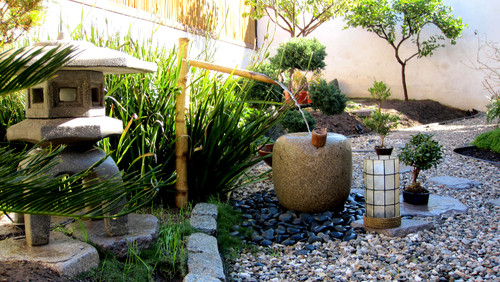Tranquil Japanese ZEN Gardens, Miniaturized Versions of Nature
Japanese gardens, these tranquil, charming gardens have been around for long time, hundreds maybe thousands of years and combine in a divine way simple, natural elements such as sand, water, rocks, stone, and vegetation to create a peaceful, Zen sanctuary.
Wonderful Japanese Garden – Beauty, Relaxation and Meditation (4K) (video)
What is characteristic of these sublime peaceful oasis is the way the various natural elements are mixed and matched to come in a perfect balanced relation to one another and the result is a miniaturized, stylized version of the surrounding nature. In fact, the garden designs are based on just three simple principles: a borrowed natural view, symbolization and a reduced scale.
1. Rock, Stones Gardens
Barren sand and rock gardens picture scenes of rivers and mountain views. The gravel and sand is raked carefully into beautiful patterns to symbolize creeks and rivers while the rocks and stones represent hills and mountains. Of course the arrangement can be done in patterns or randomly but an old tradition says rocks should be placed only and only in odd numbers. With a little imagination you have the illusion of seeing mountains from a distance, especially when you place these miniature gardens in a existing green scenery.
A rock garden can be create anywhere in your property even if you don’t have a large outdoor space. A rock garden can be created even inside. If you are looking for a tiny rock garden then you should check online, where you can find and purchase the one that fit your taste and needs.
2. Koi Fish Ponds
Koi ponds are definitely a popular element of Japanese and Chinese gardens. But in Japanese tradition they represent water, rivers, lakes and seas, bringing life and color to the garden. There are very large Koi ponds fit for a recreational area, but also they can be small and tiny to fit in your backyard.
3. Bridges
A bridge is another common element of a Japanese garden. Bridges can be made of stone or wood and can be very simple or exquisite elaborated. Some are unadorned stone or colored in a bright red.
4. Japanese Lanterns
Japanese lanterns are typically made from stone. They are carefully positioned within the garden area at special locations, usually next to a nice improvement or a building, to add beauty to the environment and to provide light. Sometimes they are placed on a small island or a small waterfall.
5. Japanese Bamboo Water Feature (Shishi-Odoshi)
These unique and lovely water features are placed usually in gardens to scare away wild animals and birds that can damage or destroy the garden. The principle is simple and efficient. An hollow bamboo tube is used together with a running water source which pour into it causing the heavier end of the bamboo tube to lift off the soil, emptying in this way the tube. When it comes quickly back down on the ground, will make a powerful sound, which will scare any wild animal.
6. Moss Gardens
Japanese gardens often use moss because of its natural beauty, resilience and versatility. Also, moss is a plant able to survive even in harsh conditions, including severe drought cold. Therefore, moss is a crucial element in any Japanese garden being considered a peaceful and lucky plant.
Read here another amazing post about Japanese gardens:
Beautiful & Mysterious Japanese Gardens, Creative Ideas (howtobuildahouseblog.com)




